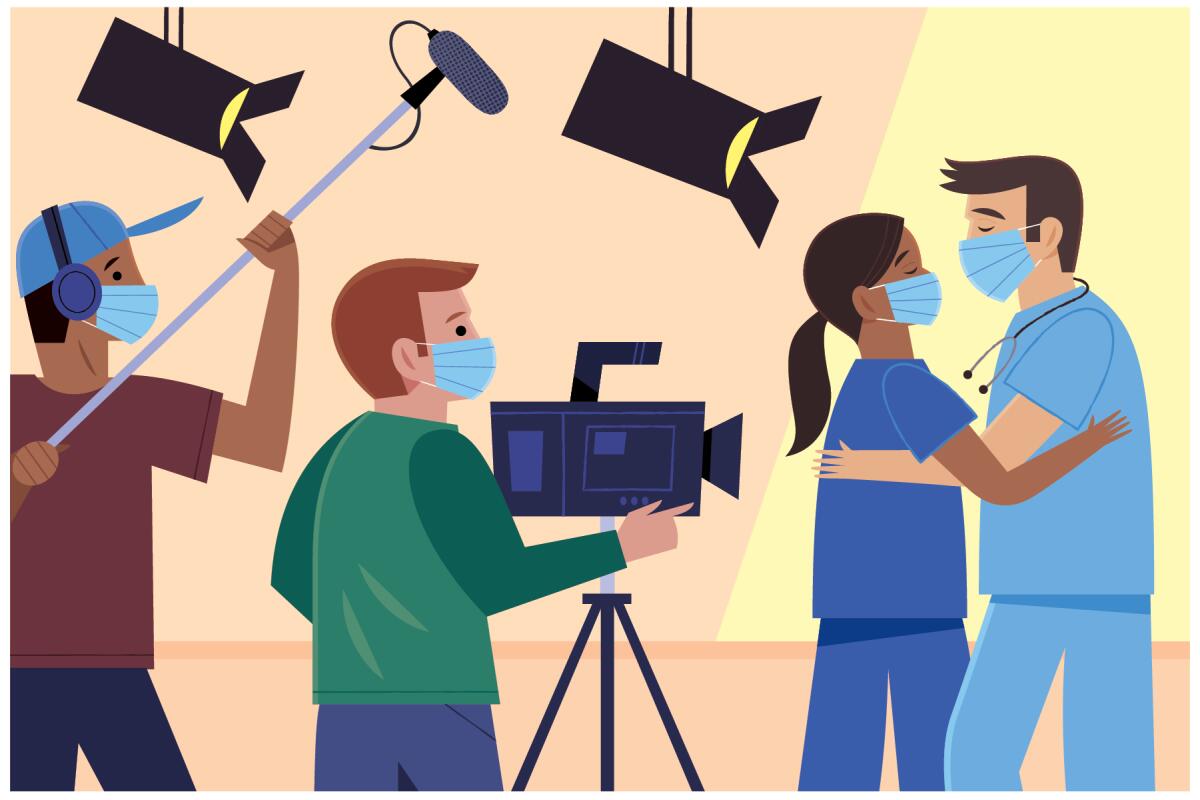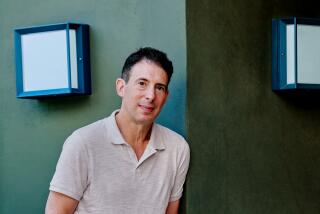To pandemic or not? How TV writers choose whether to include the harsh reality

- Share via
In spring 2020, those in the “black-ish” writers’ room faced a conundrum: To pandemic or not to pandemic? With the world heading toward lockdown and a next season that had to be written, would the Johnson family still feel the effects of what might be a passing phase, a brief blip that was old news by the time their shows began airing in the fall?
But quickly the choice — a decision made in writers’ rooms across Hollywood — became clear: They had to work the ever-changing real world into the “black-ish” universe. It was something they’d done before, but not to this extent. So with Courtney Lilly at the showrunning helm, they wrote a show that would air in September — but take place back at the start of the lockdown.
“We knew we would have to comment and address it in some way,” says Lilly. “We assumed that by the time we got to September or October we’d be in a different place — but then things started going viral again in December, and we were surprised in a negative way. We were disappointed that something we’d done months ago would still be relevant — was actually too relevant.”
It was an issue, if not the big issue, that writers across Hollywood had to face: how to plan a season amid an evolving crisis. Would their universe feature COVID-19, see it in the rearview mirror or pretend it never even happened? And if featured, what would that world even look like? It’s not as though any of them had a crystal ball.
“You have to have a little bit of ESP,” says “Law & Order: Organized Crime” showrunner Ilene Chaiken, whose show tackled it by examining how the mob and COVID intersected. “You have to calibrate how much is too much. Even if we weren’t telling a story that revolved around COVID, [the virus] would still exist on the show. We’re grounded in the real world, the world of current events.”
“A lot of crystal ball decisions were going on,” agrees Dave Caplan, executive producer on “The Conners.” On their show, one character contracted COVID, but the story lines were just as likely to revolve around economic issues and online learning. “We realized our obligation was to be realistic about what’s going on in the country, and it would feel false to not include what was going on in their lives on the show.”
Laurie Metcalf and Lecy Goranson discuss the Season 3 premiere of “The Conners,” ABC’s first comedy to go back into production during the COVID-19 pandemic.
Meanwhile, “Superstore” executive producers Gabe Miller and Jonathan Green felt they’d be cheating viewers to ignore what it was like to be considered essential (if nonmedical) workers during such an upheaval.
“One benefit is that we’re set in a store and not a hospital, so we could explore what COVID meant to these people’s work lives without seeing the worst side of the virus,” says Miller. “We could also present themes like how corporate presents itself as caring about workers and celebrates people like our characters as heroes — but doesn’t protect them.”
But for shows that were set in medical facilities, discussing the pandemic was an imperative. On “Chicago Med,” characters contracted the virus, a separate “COVID ICU” was set up, and regular testing became a part of every show. But it still wasn’t COVID 24/7. “Just because we had this horrible new disease, it didn’t mean people wouldn’t get heart attacks or cancer,” says Andy Schneider, co-showrunner with Diane Frolov.
On “Grey’s Anatomy,” showrunner Krista Vernoff did briefly consider whether “depicting the pandemic in the middle of the pandemic would be too much pandemic” but ultimately dived in with the appropriate medical elements — and then branched out to find ways to show her characters unmasked, like in a character’s backyard, which had never been seen before.
Still, she notes, even when immersed in a tragedy, TV can provide a cathartic outlet. “The news and social media provides a constant barrage of pain that can leave us numb and depressed,” she says. “What we did was provide an opportunity to focus on one story, on one character, one victory or one loss to give you time and permission to feel it.”
“Part of me wants the escape from my entertainment, for it to take me someplace else,” says “In Treatment” co-showrunner (with Jennifer Schuur) Joshua Allen. The series returned to HBO after a 10-year hiatus in large part to focus on the importance of therapy during the stressful days of a situation like COVID. “But part of me wants to see the experience of what I’m going through reflected. When it’s coming into your room and you’re consuming a story, it’s an intimate way of absorbing perspective and messages.”
Having now addressed COVID in various ways, though, many showrunners suggest they’ll be backing away from it, or treating it as less of an urgent plotline, in seasons to come. Vernoff’s new show “Rebel,” for example, will take place in a post-COVID world, she says. And her goal at “Grey’s” is to “distance ourselves so it’s a background element.”
And then there’s “Mythic Quest,” which devoted two heartfelt episodes to the pandemic — one using remote cameras, the other in a postpandemic world where characters returned to the offices in triumph.
“We wanted to have an optimistic future,” says creator-star Rob McElhenney. “We literally do not say COVID the entire [second] season. We felt if we were going to project into a future where we put it all behind us, we’d do this [return-to-work] episode and close the door on the issue.”
More to Read
From the Oscars to the Emmys.
Get the Envelope newsletter for exclusive awards season coverage, behind-the-scenes stories from the Envelope podcast and columnist Glenn Whipp’s must-read analysis.
You may occasionally receive promotional content from the Los Angeles Times.










